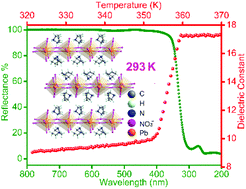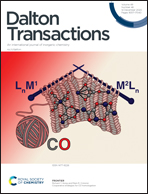Above room-temperature dielectric switching and semiconducting properties of a layered organic–inorganic hybrid compound: (C6H12N)2Pb(NO3)4†
Abstract
The well-studied star compound, CH3NH3PbI3, has attracted plenty of attention because of its remarkable optical and electrical properties. Consequently, new switching multifunctional hybrid compounds can be widely used in many fields such as solar cells, light-emitting diodes, optical data storage and so on. Therefore, switching multifunctional hybrid compounds with dielectric and semiconducting properties simultaneously will also find roles in the next generation of optoelectronic coupling materials. In fact, discovering an effective method to synthesize (multi)functional hybrid materials remains a pressing challenge. Thanks to the “quasi-spherical theory” proposed by Xiong et al., we used 7-azabicyclo[2.2.1]heptane as the quasi-spherical cation to construct molecule-based crystalline materials that exhibit responsive properties. Then, we tried to exploit the knowledge of crystal engineering and coordination chemistry to explain (multi)functional molecular materials. A layered organic–inorganic hybrid compound, (C6H12N)2Pb(NO3)4 (1), was grown and its dielectric switching property and semiconducting behaviour were investigated. Insights from differential scanning calorimetry measurements, variable-temperature X-ray structural studies, and dielectric spectroscopy revealed the origin of the phase transition, which is related to the motion of the organic ammonium and inorganic framework in solid-state crystals. Furthermore, 1 is also a wide bandgap semiconductor with an optical bandgap of 3.53 eV. The realization of switching and semiconducting properties simultaneously in layered Pb-based perovskites has a great significance toward research into hybrid compounds and the development of dielectric–optoelectronic integrated materials.



 Please wait while we load your content...
Please wait while we load your content...